Spatial Distribution Characteristics of Traditional Villages and Influence Factors Thereof in Hilly and Gully Areas of Northern Shaanxi
Abstract
:1. Introduction
2. Literature Review
3. Research Object and Methodology
3.1. Study Area
3.2. Data Source and Processing
3.3. Research Methodology
4. Results
4.1. Geographical Distribution Characteristics of Traditional Villages in Northern Shaanxi
4.1.1. Overall Spatial Distribution Characteristics
4.1.2. Spatial Distribution Balance
4.1.3. Analysis of Agglomeration Areas in Spatial Distribution
4.2. Influence Factors of Spatial Distribution of Traditional Villages in Northern Shaanxi
4.2.1. Natural Environment Factors
Relationship between Spatial Distribution and Topography of Traditional Villages
Relationship between Spatial Distribution and River Systems of Traditional Villages
Relationship between Spatial Distribution and Climate Environment of Traditional Villages
4.2.2. Social and Human Factors
Relationship between Spatial Distribution and Socioeconomic Situation of Traditional Villages
Relationship between Spatial Distribution and Historical and Cultural Heritage of Traditional Villages
4.3. Quantification of Influence Factors of Spatial Distribution
4.3.1. Single-Factor Detection
4.3.2. Interaction Detection of Factors
5. Discussion
5.1. Natural Environment Factors Are the Basis for Sustainable Development of Traditional Villages
5.2. Social and Economic Factors Are Core Motivation for Distribution Characteristics of Traditional Villages
6. Conclusions and Future Work
- The spatial distribution of the traditional villages in the hilly and gully areas of northern Shaanxi presents an uneven agglomeration distribution, with Mizhi, Suide, and Jiaxian as the main core agglomeration areas and Yanchuan as a secondary core agglomeration area, and an outward radiation forms with the “dual-core” as the center.
- Most of the traditional villages in the hilly and gully areas of northern Shaanxi are located in areas with a middle/high altitude of 700~1200 m and a slope of 10°~20° and in mountainous regions with a moderate relief with a south-facing aspect. The traditional villages are mostly located in the Wuding-Qingjian River Basin, within the 600 m river buffer area; the areas with an average annual temperature between 8.9 and 10.5 °C, an annual rainfall between 450 and 550 mm, and solar radiation between 5800 and 6000 MJ/m2 have a more concentrated distribution of villages. Among the influential factors, the distribution of the traditional villages is positively correlated with slope, average annual temperature, and solar radiation, and it is negatively correlated with the distance from a river; the elevation, aspect, terrain undulation, and rainfall are distributed in the middle.
- Since the 1990s, the uneven development of the socio-economic level has had a great impact on the distribution of the traditional villages. Among them, in areas with high population density and low per capita GDP, there are more traditional villages, and the correlation between spatial distribution and the urbanization rate fluctuates.
- The results of GeoDetector show that socio-economic factors, such as per capita GDP, population density, and urbanization rate, have the strongest influence on the spatial distribution of the traditional villages, followed by climate factors such as rainfall, average temperature, and solar radiation, while geographical factors, such as terrain undulation, elevation, aspect, slope, and distance from rivers, have a weak influence. The interaction enhancement effect of “rainfall ∩ population density, population density ∩ intangible cultural heritage, solar radiation ∩ population density” is the most obvious.
- In terms of influence mechanisms, the natural environmental factors are the basis for the formation and development of the traditional villages, and the socio-economic factors determine their development direction. The locations of the loess hilly landform and the agro-pastoral transition zone have created a unique cave architecture and regional culture in the hilly and gully areas of northern Shaanxi. This is also the fundamental reason why the spatial distribution pattern of the traditional villages is different from that of other regions, indicating that the traditional villages are the result of long-term adaptations between man and nature.
- Promote the integrated development of traditional agriculture into primary, secondary, and tertiary industries, using traditional village tourism resources to develop tourism and the agricultural product processing industries and to drive economic growth in low-income areas with high population density.
- Against the background of the transformation of the Loess Plateau from a warm-dry to a warm-humid climate, the trend of ecological deterioration is reversed through ecological restoration, and the climate comfort of the human settlement space is improved in the process of settlement transformation; overdevelopment is avoided, and the coordinated development of the human settlement environment and the ecological environment is promoted.
- The protection of traditional villages should have a broader perspective, according to the characteristics of traditional village agglomeration and distribution, comprehensively and systematically delineating cultural areas of different types and functions, highlighting core regional cultures, and formulating special protection plans for village cultural areas.
Author Contributions
Funding
Institutional Review Board Statement
Informed Consent Statement
Data Availability Statement
Conflicts of Interest
Appendix A
| Category | Evaluate Method | Index | Indicator Decomposition |
|---|---|---|---|
| Traditional architecture of the village | quantitative assessment | Longevity | The earliest surviving building was built |
| Scarcity | The age of construction in a cluster of traditional buildings | ||
| Scale | The level of cultural relics protection unit | ||
| Proportion | Traditional building footprint Proportion of the construction land area of the village | ||
| Abundance | Types of building functions | ||
| qualitative assessment | Completeness | The existing traditional buildings (groups) and their architectural details and even the surrounding environment are preserved | |
| Aesthetic value of craftsmanship | The existing traditional buildings (groups) have aesthetic values such as architectural shape, structure, materials, or decoration | ||
| Traditional craftsmanship is inherited | Traditional techniques are still widely used to create everyday life buildings | ||
| Site selection and layout | quantitative assessment | Longevity | The current site of the village was formed |
| Abundance | Types of existing historical environmental elements | ||
| qualitative assessment | Pattern integrity | The extent to which the traditional pattern of the village is preserved | |
| Scientific and cultural values | Village site selection, planning, and creation reflect scientific, cultural, historical, and archaeological values | ||
| Coordination | The village maintains a harmonious symbiotic relationship with the surrounding beautiful natural landscape environment or traditional idyllic scenery | ||
| Intangible cultural heritage | quantitative assessment | Scarcity | Level of intangible cultural heritage |
| Abundance | Categories of intangible cultural heritage | ||
| Continuity | Continuous inheritance time to the present | ||
| Scale | Scale of legacy activities | ||
| Inheritors | Whether there is a clear representative inheritor | ||
| qualitative assessment | Liveness | Inheritance | |
| Dependency | The degree to which rituals, bearers, materials, crafts, and other practices related to intangible cultural heritage depend on the village and its surrounding environment |
| No. | Name | Nuclear Density | Elevation | Slope | Aspect | Terrain Relief | Distance to River | Solar Radiation | Average Temperature | Rainfall | GDP per Capita | Urbanization Rate | Population Density | Number of Intangible Cultural Anomalies |
|---|---|---|---|---|---|---|---|---|---|---|---|---|---|---|
| 1 | Luojian | 0.00 | 4 | 1 | 1 | 1 | 3 | 5 | 2 | 1 | 4 | 5 | 3 | 2 |
| 2 | Jiadamao | 0.00 | 4 | 1 | 4 | 1 | 2 | 5 | 2 | 1 | 3 | 3 | 3 | 2 |
| 3 | Xiangshui | 0.00 | 3 | 1 | 3 | 1 | 2 | 5 | 2 | 1 | 3 | 3 | 3 | 2 |
| 4 | Wulongshan | 0.00 | 3 | 1 | 3 | 1 | 1 | 5 | 2 | 1 | 3 | 3 | 3 | 2 |
| 5 | Wangpizhuang | 0.00 | 4 | 1 | 4 | 1 | 2 | 5 | 2 | 1 | 3 | 3 | 3 | 2 |
| 6 | Zhenjing | 0.00 | 5 | 1 | 3 | 1 | 4 | 5 | 2 | 1 | 4 | 4 | 2 | 4 |
| 7 | Heyi | 0.02 | 3 | 4 | 4 | 4 | 1 | 3 | 4 | 3 | 1 | 2 | 5 | 4 |
| 8 | Aijiagou | 0.02 | 3 | 3 | 3 | 3 | 3 | 3 | 4 | 3 | 1 | 2 | 5 | 4 |
| 9 | Changjiagou | 0.02 | 3 | 4 | 4 | 3 | 1 | 3 | 4 | 3 | 1 | 2 | 5 | 4 |
| 10 | Guojiagou | 0.02 | 3 | 3 | 3 | 3 | 2 | 3 | 4 | 3 | 1 | 2 | 5 | 4 |
| 11 | Huyan | 0.01 | 4 | 4 | 3 | 4 | 5 | 3 | 4 | 4 | 1 | 2 | 5 | 4 |
| 12 | Liangjiajia | 0.02 | 4 | 3 | 3 | 3 | 3 | 3 | 4 | 3 | 1 | 2 | 5 | 4 |
| 13 | Zhongjiao | 0.02 | 4 | 4 | 4 | 3 | 1 | 3 | 4 | 3 | 1 | 2 | 5 | 4 |
| 14 | Yangjiagou | 0.03 | 4 | 3 | 3 | 2 | 1 | 4 | 3 | 2 | 1 | 2 | 5 | 3 |
| 15 | Gaomiaoshan | 0.03 | 3 | 3 | 4 | 2 | 1 | 4 | 3 | 2 | 1 | 2 | 5 | 3 |
| 16 | Taozhen | 0.03 | 4 | 3 | 3 | 2 | 2 | 4 | 3 | 2 | 1 | 2 | 5 | 3 |
| 17 | Heigeta | 0.03 | 4 | 3 | 3 | 3 | 1 | 4 | 3 | 2 | 1 | 2 | 5 | 3 |
| 18 | Sigou | 0.03 | 4 | 3 | 5 | 3 | 1 | 4 | 3 | 2 | 1 | 2 | 5 | 3 |
| 19 | Yujiacha | 0.03 | 3 | 3 | 4 | 2 | 1 | 4 | 3 | 2 | 1 | 2 | 5 | 3 |
| 20 | Baixingzhuang | 0.01 | 3 | 2 | 2 | 2 | 1 | 4 | 3 | 2 | 1 | 2 | 5 | 3 |
| 21 | Liujiamao | 0.03 | 4 | 3 | 3 | 3 | 2 | 4 | 3 | 2 | 1 | 2 | 5 | 3 |
| 22 | Zhenziwan | 0.02 | 2 | 2 | 1 | 1 | 1 | 4 | 3 | 2 | 1 | 2 | 5 | 3 |
| 23 | Shenquan | 0.01 | 2 | 2 | 3 | 1 | 2 | 4 | 2 | 2 | 2 | 1 | 4 | 2 |
| 24 | Zhangzhuang | 0.01 | 2 | 2 | 3 | 3 | 4 | 4 | 2 | 2 | 2 | 1 | 4 | 2 |
| 25 | Shaping | 0.02 | 2 | 4 | 3 | 3 | 2 | 3 | 3 | 3 | 2 | 1 | 4 | 2 |
| 26 | Yukou | 0.01 | 1 | 3 | 2 | 4 | 4 | 4 | 2 | 2 | 2 | 1 | 4 | 2 |
| 27 | Nihegou | 0.00 | 2 | 3 | 1 | 4 | 2 | 4 | 2 | 1 | 2 | 1 | 4 | 2 |
| 28 | Mutouyu | 0.01 | 1 | 2 | 1 | 1 | 3 | 4 | 3 | 2 | 2 | 1 | 4 | 2 |
| 29 | Heyeping | 0.01 | 1 | 4 | 1 | 4 | 2 | 3 | 3 | 3 | 2 | 1 | 4 | 2 |
| 30 | Liujiaping | 0.01 | 1 | 3 | 2 | 2 | 1 | 3 | 3 | 3 | 2 | 1 | 4 | 2 |
| 31 | Gaojie | 0.01 | 1 | 3 | 4 | 4 | 2 | 2 | 4 | 4 | 2 | 2 | 4 | 2 |
| 32 | Zhangzhai | 0.00 | 2 | 2 | 1 | 3 | 4 | 4 | 4 | 2 | 2 | 2 | 4 | 3 |
| 33 | Mianhugou | 0.00 | 4 | 5 | 3 | 4 | 1 | 3 | 3 | 3 | 2 | 2 | 4 | 3 |
| 34 | Yuanzeping | 0.00 | 3 | 4 | 3 | 4 | 1 | 4 | 4 | 2 | 2 | 2 | 4 | 3 |
| 35 | Zhenshi | 0.00 | 3 | 3 | 3 | 5 | 2 | 1 | 5 | 5 | 2 | 5 | 5 | 5 |
| 36 | Anding | 0.00 | 5 | 4 | 3 | 5 | 3 | 2 | 3 | 3 | 1 | 4 | 3 | 3 |
| 37 | Zhaojiahe | 0.01 | 3 | 4 | 3 | 4 | 1 | 2 | 4 | 4 | 3 | 4 | 2 | 2 |
| 38 | Liangjiahe | 0.01 | 3 | 5 | 3 | 5 | 1 | 2 | 4 | 4 | 3 | 4 | 2 | 2 |
| 39 | Majiawan | 0.02 | 3 | 4 | 4 | 5 | 1 | 2 | 4 | 4 | 3 | 4 | 2 | 2 |
| 40 | Shangtianjia | 0.01 | 3 | 5 | 2 | 5 | 2 | 2 | 4 | 3 | 3 | 4 | 2 | 2 |
| 41 | Zhenjiawan | 0.02 | 2 | 4 | 3 | 5 | 1 | 2 | 4 | 4 | 3 | 4 | 2 | 2 |
| 42 | Taixiangsi | 0.02 | 2 | 4 | 2 | 5 | 2 | 2 | 4 | 4 | 3 | 4 | 2 | 2 |
| 43 | Nianpan | 0.01 | 1 | 2 | 3 | 3 | 4 | 2 | 4 | 5 | 3 | 4 | 2 | 2 |
| 44 | Liujiashan | 0.01 | 1 | 2 | 1 | 3 | 3 | 2 | 4 | 5 | 3 | 4 | 2 | 2 |
| 45 | Liangshui’an | 0.01 | 1 | 3 | 1 | 4 | 5 | 1 | 5 | 5 | 1 | 2 | 1 | 1 |
| 46 | Fangya | 0.00 | 3 | 2 | 3 | 2 | 2 | 4 | 2 | 1 | 4 | 5 | 3 | 2 |
| 47 | Zhaiwa | 0.01 | 2 | 1 | 5 | 1 | 4 | 4 | 3 | 2 | 4 | 5 | 3 | 2 |
| 48 | Chenjiapo | 0.02 | 2 | 1 | 5 | 1 | 3 | 4 | 3 | 2 | 4 | 5 | 3 | 2 |
| 49 | Lijiawa | 0.01 | 2 | 1 | 1 | 1 | 2 | 4 | 1 | 1 | 5 | 4 | 2 | 1 |
| 50 | Sunshike | 0.00 | 2 | 2 | 3 | 1 | 3 | 4 | 1 | 1 | 5 | 4 | 2 | 1 |
| 51 | Caiyuangou | 0.00 | 4 | 2 | 3 | 2 | 1 | 4 | 1 | 1 | 5 | 4 | 2 | 1 |
| 52 | Shamaotou | 0.00 | 4 | 1 | 1 | 1 | 3 | 4 | 1 | 1 | 5 | 4 | 2 | 1 |
| 53 | Wenlujia | 0.00 | 4 | 2 | 3 | 2 | 1 | 4 | 1 | 1 | 5 | 4 | 2 | 1 |
| 54 | Huangfu | 0.00 | 5 | 1 | 2 | 1 | 5 | 4 | 1 | 1 | 5 | 4 | 2 | 1 |
| 55 | Chengnei | 0.01 | 2 | 1 | 1 | 1 | 1 | 4 | 1 | 1 | 5 | 4 | 2 | 1 |
| 56 | Hazhen | 0.01 | 2 | 1 | 2 | 1 | 3 | 4 | 1 | 1 | 5 | 4 | 2 | 1 |
| 57 | Shaliang | 0.00 | 3 | 2 | 2 | 2 | 3 | 4 | 1 | 1 | 5 | 4 | 2 | 1 |
| 58 | Mugua | 0.02 | 4 | 4 | 4 | 3 | 1 | 3 | 4 | 3 | 1 | 2 | 5 | 4 |
| 59 | Yujiaping | 0.02 | 3 | 4 | 4 | 3 | 1 | 3 | 4 | 3 | 1 | 2 | 5 | 4 |
| 60 | Qianyuanze | 0.02 | 2 | 4 | 2 | 3 | 2 | 3 | 4 | 3 | 1 | 2 | 5 | 4 |
| 61 | Yaoqu | 0.01 | 2 | 3 | 4 | 3 | 1 | 4 | 4 | 2 | 1 | 2 | 5 | 4 |
| 62 | Ciyaogou | 0.02 | 1 | 2 | 2 | 3 | 1 | 3 | 4 | 3 | 1 | 2 | 5 | 4 |
| 63 | Shengou | 0.01 | 2 | 4 | 2 | 4 | 1 | 4 | 5 | 2 | 1 | 2 | 5 | 4 |
| 64 | Sanshilipu | 0.01 | 2 | 3 | 3 | 3 | 1 | 3 | 4 | 3 | 1 | 2 | 5 | 4 |
| 65 | Sunjiacha | 0.02 | 2 | 2 | 2 | 3 | 1 | 3 | 4 | 3 | 1 | 2 | 5 | 4 |
| 66 | Zhifanggou | 0.02 | 4 | 2 | 3 | 2 | 5 | 3 | 4 | 3 | 1 | 2 | 5 | 4 |
| 67 | Xuejiamao | 0.02 | 3 | 5 | 4 | 4 | 1 | 3 | 4 | 3 | 1 | 2 | 5 | 4 |
| 68 | Haojiaqiao | 0.02 | 2 | 5 | 4 | 4 | 1 | 3 | 4 | 3 | 1 | 2 | 5 | 4 |
| 69 | Tianzhuang | 0.02 | 1 | 1 | 2 | 2 | 3 | 3 | 4 | 3 | 1 | 2 | 5 | 4 |
| 70 | Haimanping | 0.01 | 1 | 2 | 3 | 3 | 3 | 3 | 4 | 3 | 1 | 2 | 5 | 4 |
| 71 | Qianping | 0.02 | 2 | 4 | 4 | 4 | 1 | 3 | 4 | 3 | 1 | 2 | 5 | 4 |
| 72 | Wangjiagou | 0.02 | 3 | 2 | 2 | 4 | 3 | 3 | 4 | 3 | 1 | 2 | 5 | 4 |
| 73 | Leijiagou | 0.02 | 3 | 3 | 5 | 3 | 1 | 3 | 4 | 3 | 1 | 2 | 5 | 4 |
| 74 | Tiejiaping | 0.02 | 3 | 4 | 3 | 3 | 1 | 4 | 3 | 2 | 1 | 2 | 5 | 4 |
| 75 | Sujiageta | 0.01 | 3 | 3 | 3 | 3 | 1 | 4 | 4 | 2 | 1 | 2 | 5 | 4 |
| 76 | Zhifanggou | 0.02 | 3 | 3 | 5 | 3 | 2 | 4 | 4 | 2 | 1 | 2 | 5 | 4 |
| 77 | Xuejiaqu | 0.01 | 2 | 4 | 3 | 3 | 1 | 4 | 5 | 2 | 1 | 2 | 5 | 4 |
| 78 | Heijiagou | 0.02 | 3 | 4 | 3 | 3 | 1 | 4 | 3 | 3 | 1 | 2 | 5 | 4 |
| 79 | Qizhen | 0.01 | 1 | 2 | 1 | 2 | 2 | 3 | 4 | 4 | 1 | 2 | 5 | 4 |
| 80 | Gaojiagou | 0.03 | 3 | 3 | 4 | 2 | 1 | 4 | 3 | 2 | 1 | 2 | 5 | 3 |
| 81 | Leijiacha | 0.02 | 3 | 3 | 2 | 2 | 2 | 4 | 3 | 2 | 1 | 2 | 5 | 3 |
| 82 | Houjiaping | 0.02 | 3 | 3 | 3 | 2 | 4 | 4 | 3 | 2 | 1 | 2 | 5 | 3 |
| 83 | Shizileng | 0.02 | 3 | 3 | 3 | 2 | 4 | 4 | 3 | 2 | 1 | 2 | 5 | 3 |
| 84 | Qianping | 0.00 | 4 | 2 | 3 | 2 | 5 | 4 | 3 | 2 | 1 | 2 | 5 | 3 |
| 85 | Lijiata | 0.02 | 3 | 4 | 2 | 3 | 1 | 4 | 3 | 2 | 1 | 2 | 5 | 3 |
| 86 | Gaoxigou | 0.02 | 2 | 1 | 1 | 1 | 3 | 4 | 3 | 2 | 1 | 2 | 5 | 3 |
| 87 | Jiqiao | 0.01 | 3 | 2 | 1 | 2 | 3 | 4 | 2 | 1 | 1 | 2 | 5 | 3 |
| 88 | Dujiashigou | 0.01 | 4 | 2 | 4 | 1 | 1 | 4 | 2 | 1 | 4 | 5 | 3 | 2 |
| 89 | Liujiawa | 0.02 | 3 | 3 | 4 | 2 | 2 | 4 | 3 | 2 | 1 | 2 | 5 | 3 |
| 90 | Tianwangta | 0.01 | 3 | 3 | 3 | 2 | 1 | 4 | 3 | 2 | 1 | 2 | 5 | 3 |
| 91 | Heishiyao | 0.03 | 4 | 3 | 4 | 2 | 1 | 4 | 3 | 2 | 1 | 2 | 5 | 3 |
| 92 | Mahuyu | 0.03 | 4 | 3 | 4 | 3 | 1 | 4 | 3 | 2 | 1 | 2 | 5 | 3 |
| 93 | Lijiazhan | 0.03 | 3 | 3 | 3 | 2 | 3 | 4 | 3 | 2 | 1 | 2 | 5 | 3 |
| 94 | Zhangjiaya | 0.01 | 4 | 3 | 2 | 2 | 4 | 4 | 3 | 2 | 1 | 2 | 5 | 3 |
| 95 | Mutouzegou | 0.02 | 4 | 3 | 3 | 2 | 1 | 4 | 3 | 2 | 1 | 2 | 5 | 3 |
| 96 | Zhejiagelao | 0.02 | 2 | 2 | 5 | 2 | 1 | 4 | 3 | 2 | 1 | 2 | 5 | 3 |
| 97 | Gongjiaqiao | 0.02 | 2 | 1 | 4 | 1 | 3 | 4 | 3 | 2 | 1 | 2 | 5 | 3 |
| 98 | Majiazeyuan | 0.01 | 2 | 3 | 2 | 3 | 1 | 4 | 3 | 2 | 2 | 1 | 4 | 2 |
| 99 | Lvjiajian | 0.00 | 1 | 3 | 1 | 4 | 3 | 3 | 4 | 4 | 2 | 3 | 5 | 1 |
| 100 | Hongyawa | 0.01 | 2 | 4 | 4 | 2 | 3 | 3 | 4 | 4 | 2 | 3 | 5 | 1 |
| 101 | Jingjiagou | 0.02 | 2 | 4 | 3 | 4 | 2 | 3 | 3 | 3 | 2 | 3 | 5 | 1 |
| 102 | Wangshagou | 0.02 | 3 | 4 | 4 | 3 | 2 | 3 | 3 | 3 | 2 | 3 | 5 | 1 |
| 103 | Leijiamao | 0.01 | 2 | 4 | 3 | 4 | 1 | 2 | 4 | 4 | 2 | 2 | 4 | 2 |
| 104 | Aodian | 0.01 | 1 | 2 | 4 | 3 | 4 | 2 | 4 | 4 | 2 | 2 | 4 | 2 |
| 105 | Jingjiahe | 0.01 | 1 | 3 | 2 | 4 | 3 | 2 | 4 | 4 | 2 | 2 | 4 | 2 |
| 106 | Wangping | 0.01 | 2 | 3 | 5 | 4 | 1 | 2 | 4 | 3 | 2 | 2 | 4 | 2 |
| 107 | Chiniuwa | 0.01 | 3 | 4 | 4 | 3 | 2 | 3 | 4 | 3 | 2 | 2 | 4 | 3 |
| 108 | Chengli | 0.00 | 3 | 2 | 1 | 3 | 3 | 3 | 3 | 2 | 2 | 2 | 4 | 3 |
| 109 | Gaojiazhuang | 0.00 | 3 | 5 | 2 | 5 | 3 | 2 | 4 | 4 | 2 | 5 | 5 | 5 |
| 110 | Gaojialeng | 0.01 | 3 | 5 | 2 | 5 | 1 | 2 | 4 | 4 | 2 | 5 | 5 | 5 |
| 111 | Sigou | 0.00 | 4 | 4 | 3 | 4 | 3 | 1 | 5 | 5 | 2 | 5 | 5 | 5 |
| 112 | Yuanjiagou | 0.01 | 5 | 4 | 3 | 4 | 3 | 1 | 4 | 4 | 2 | 5 | 5 | 5 |
| 113 | Yuanjiagou | 0.00 | 4 | 5 | 2 | 5 | 2 | 1 | 3 | 4 | 2 | 5 | 5 | 5 |
| 114 | Wangsuli | 0.00 | 3 | 3 | 1 | 4 | 3 | 1 | 3 | 4 | 2 | 5 | 5 | 5 |
| 115 | Shitaisi | 0.00 | 3 | 3 | 4 | 4 | 2 | 1 | 3 | 4 | 2 | 5 | 5 | 5 |
| 116 | Wangjiabao | 0.00 | 5 | 5 | 2 | 5 | 1 | 1 | 4 | 4 | 2 | 5 | 5 | 5 |
| 117 | Xuejiachengze | 0.00 | 5 | 3 | 3 | 4 | 3 | 1 | 3 | 4 | 3 | 3 | 1 | 3 |
| 118 | Yingpan | 0.00 | 5 | 4 | 4 | 4 | 4 | 3 | 3 | 2 | 1 | 4 | 3 | 3 |
| 119 | Dongzhen | 0.01 | 4 | 4 | 3 | 4 | 2 | 2 | 3 | 3 | 1 | 4 | 3 | 3 |
| 120 | Gutun | 0.01 | 3 | 4 | 2 | 5 | 2 | 2 | 4 | 4 | 3 | 4 | 2 | 2 |
| 121 | Mafang | 0.02 | 2 | 4 | 2 | 5 | 2 | 2 | 4 | 4 | 3 | 4 | 2 | 2 |
| 122 | Maojiabaoze | 0.02 | 2 | 5 | 3 | 5 | 1 | 2 | 4 | 4 | 3 | 4 | 2 | 2 |
| 123 | Miaogou | 0.02 | 2 | 4 | 4 | 5 | 3 | 2 | 4 | 4 | 3 | 4 | 2 | 2 |
| 124 | Lizhuang | 0.02 | 2 | 5 | 4 | 5 | 1 | 2 | 4 | 4 | 3 | 4 | 2 | 2 |
| 125 | Kangping | 0.01 | 3 | 5 | 3 | 5 | 1 | 2 | 4 | 4 | 3 | 4 | 2 | 2 |
| 126 | Longsi | 0.01 | 3 | 5 | 3 | 5 | 2 | 2 | 4 | 4 | 3 | 4 | 2 | 2 |
| 127 | Weita | 0.01 | 3 | 4 | 3 | 4 | 5 | 2 | 4 | 4 | 3 | 4 | 2 | 2 |
| 128 | Zhoujiashan | 0.01 | 3 | 5 | 3 | 5 | 1 | 2 | 4 | 4 | 3 | 4 | 2 | 2 |
| 129 | Resiwan | 0.01 | 2 | 5 | 3 | 5 | 1 | 2 | 4 | 4 | 3 | 4 | 2 | 2 |
| 130 | Zhaojiayadi | 0.02 | 3 | 4 | 3 | 5 | 2 | 2 | 4 | 4 | 3 | 4 | 2 | 2 |
| 131 | Weijiacha | 0.00 | 1 | 3 | 2 | 4 | 4 | 2 | 4 | 4 | 3 | 4 | 2 | 2 |
| 132 | Shiyaotai | 0.01 | 1 | 4 | 1 | 5 | 4 | 1 | 5 | 5 | 1 | 2 | 1 | 1 |
| 133 | Gaojiagetai | 0.01 | 1 | 2 | 1 | 3 | 4 | 1 | 5 | 5 | 1 | 2 | 1 | 1 |
| 134 | Liujiagou | 0.00 | 5 | 5 | 3 | 5 | 1 | 1 | 2 | 3 | 4 | 4 | 1 | 4 |
| 135 | Liumajiageta | 0.00 | 5 | 5 | 3 | 5 | 2 | 1 | 2 | 3 | 4 | 4 | 1 | 4 |
| 136 | Sheyou | 0.00 | 5 | 4 | 4 | 5 | 1 | 1 | 3 | 4 | 4 | 4 | 1 | 4 |
| 137 | Zhangjiahe | 0.00 | 5 | 4 | 3 | 4 | 2 | 1 | 2 | 3 | 4 | 4 | 1 | 4 |
| 138 | Lvjiahe | 0.00 | 5 | 3 | 3 | 4 | 2 | 2 | 1 | 3 | 4 | 4 | 1 | 4 |
| 139 | Qiaojiahe | 0.00 | 4 | 3 | 2 | 3 | 2 | 4 | 3 | 2 | 3 | 3 | 3 | 2 |
| 140 | Xiadamu | 0.01 | 4 | 1 | 4 | 1 | 1 | 5 | 2 | 1 | 3 | 3 | 3 | 2 |
| 141 | Wacunhe | 0.00 | 3 | 4 | 2 | 3 | 1 | 4 | 2 | 1 | 5 | 5 | 2 | 4 |
| 142 | Tuojiachuan | 0.00 | 1 | 1 | 2 | 1 | 2 | 4 | 2 | 1 | 5 | 5 | 2 | 4 |
| 143 | Suanjiageta | 0.00 | 1 | 2 | 2 | 3 | 3 | 4 | 2 | 1 | 5 | 5 | 2 | 4 |
| 144 | Xinshenggu | 0.02 | 3 | 3 | 2 | 2 | 1 | 4 | 3 | 2 | 1 | 2 | 5 | 3 |
| 145 | Majiadian | 0.02 | 3 | 3 | 2 | 2 | 1 | 4 | 3 | 2 | 1 | 2 | 5 | 3 |
| 146 | Si | 0.02 | 3 | 3 | 3 | 2 | 1 | 4 | 3 | 2 | 1 | 2 | 5 | 3 |
| 147 | Tianjiayuan | 0.02 | 2 | 3 | 5 | 2 | 3 | 3 | 4 | 3 | 1 | 2 | 5 | 4 |
| 148 | Shangpo | 0.01 | 3 | 5 | 4 | 4 | 1 | 3 | 4 | 3 | 2 | 2 | 4 | 2 |
| 149 | Xiapo | 0.00 | 1 | 2 | 1 | 3 | 4 | 2 | 4 | 4 | 3 | 4 | 2 | 2 |
| 150 | Baishachuan | 0.02 | 3 | 5 | 2 | 5 | 1 | 2 | 4 | 4 | 3 | 4 | 2 | 2 |
| 151 | Diaoping | 0.01 | 4 | 5 | 4 | 5 | 5 | 2 | 4 | 4 | 3 | 4 | 2 | 2 |
| 152 | Malaozhuang | 0.00 | 3 | 3 | 2 | 4 | 1 | 2 | 4 | 3 | 1 | 4 | 3 | 3 |
| 153 | yaozichuan | 0.00 | 4 | 3 | 2 | 4 | 1 | 3 | 3 | 3 | 1 | 4 | 3 | 3 |
| 154 | Jintang | 0.00 | 4 | 5 | 3 | 5 | 2 | 4 | 3 | 2 | 1 | 4 | 3 | 3 |
| X1 | X2 | X3 | X4 | X5 | X6 | X7 | X8 | X9 | X10 | X11 | X12 | |
|---|---|---|---|---|---|---|---|---|---|---|---|---|
| q statistic | 0.17 | 0.11 | 0.12 | 0.18 | 0.09 | 0.21 | 0.28 | 0.30 | 0.39 | 0.31 | 0.37 | 0.20 |
| p value | 0.00 | 0.00 | 0.01 | 0.00 | 0.01 | 0.00 | 0.00 | 0.00 | 0.00 | 0.00 | 0.00 | 0.00 |
| X1 | X2 | X3 | X4 | X5 | X6 | X7 | X8 | X9 | X10 | X11 | X12 | |
|---|---|---|---|---|---|---|---|---|---|---|---|---|
| X1 | 0.1713 | - | - | - | - | - | - | - | - | - | - | - |
| X2 | 0.4283 | 0.1101 | - | - | - | - | - | - | - | - | - | - |
| X3 | 0.3271 | 0.3354 | 0.1223 | - | - | - | - | - | - | - | - | - |
| X4 | 0.4192 | 0.4320 | 0.3884 | 0.1823 | - | - | - | - | - | - | - | - |
| X5 | 0.2534 | 0.2825 | 0.2418 | 0.3209 | 0.0908 | - | - | - | - | - | - | - |
| X6 | 0.3728 | 0.4334 | 0.3949 | 0.3636 | 0.3236 | 0.2120 | - | - | - | - | - | - |
| X7 | 0.4466 | 0.4022 | 0.3979 | 0.5087 | 0.3999 | 0.5426 | 0.2791 | - | - | - | - | - |
| X8 | 0.5045 | 0.4738 | 0.3996 | 0.5133 | 0.4156 | 0.4706 | 0.4907 | 0.2963 | - | - | - | - |
| X9 | 0.6004 | 0.5468 | 0.5142 | 0.6074 | 0.5033 | 0.5784 | 0.5303 | 0.5722 | 0.3909 | - | - | - |
| X10 | 0.5310 | 0.4968 | 0.4390 | 0.4906 | 0.4068 | 0.5132 | 0.5246 | 0.5721 | 0.5948 | 0.3088 | - | - |
| X11 | 0.5210 | 0.5300 | 0.5091 | 0.6314 | 0.4639 | 0.6329 | 0.5353 | 0.6971 | 0.6112 | 0.5900 | 0.3699 | - |
| X12 | 0.4362 | 0.4783 | 0.3302 | 0.5460 | 0.3410 | 0.5566 | 0.4842 | 0.5026 | 0.4799 | 0.5391 | 0.6565 | 0.1963 |
References
- Wu, F.Q.; Zhou, K. Less is more—Rural planning from the perspective of village cultural landscape. J. Hum. Settl. West China 2015, 30, 44–49. [Google Scholar]
- Li, B.H.; Yin, S.; Liu, P.L.; Dou, Y.D. Spatial distribution of traditional villages and the influencing factors in Hunan Province. Econ. Geogr. 2015, 35, 189–194. [Google Scholar]
- Xu, J.H.; Le, B.M.; Mao, Z.; Liu, S. Influencing Factors and Protection Modes of the Spatial Pattern of Traditional Villages in Hunan Province. Econ. Geogr. 2020, 40, 147–153. [Google Scholar]
- Yin, W.; Chen, P.D.; Qin, J.; Chen, L.L.; Xie, K.; Li, G. Bashu cultural corridor construction research: Spatial distribution characteristics and influencing factors of national traditional villages in Chengdu-Chongqing Region. Chin. Overseas Arch. 2022, 6, 42–47. [Google Scholar]
- The Ministry of Housing and Urban-Rural Development and Other Departments Announced the List of Traditional Chinese Villages. Available online: http://www.chuantongcunluo.com/ (accessed on 22 August 2022).
- The Central Committee of the Communist Party of China and the State Council Issued the Strategic Plan for Rural Revitalization (2018–2022). Available online: http://www.gov.cn/xinwen/2018-09/26/content_5325534.htm (accessed on 29 October 2022).
- Zhang, Y.; Jia, Y.F.; He, Y. The Study of Integrated Conservation Method of Traditional Plain Bao-village, taking Pingyao historic villages as an example. Urban Dev. Stud. 2015, 22, 104–110. [Google Scholar]
- Long, B.; Zhao, Y. Village Landscape Characteristics and Evolution of Tengchong in Yunnan from the Regional Perspective. South Archit. 2022, 5, 35–44. [Google Scholar]
- Gauthiez, B. The History of urban morphology. Urban Morphol. 2004, 8, 72. [Google Scholar] [CrossRef]
- Williams, M. The Apple of my eye: Carl Sauer and Historical Geography. J. Hist. Geogr. 1993, 9, 1–28. [Google Scholar] [CrossRef]
- Sauer, C.O. The Fourth Dimension of Geography. Ann. Assoc. Am. Geogr. 1974, 64, 189–192. [Google Scholar] [CrossRef]
- Erik, G.B.; Victoria, R.G.; Per, O.; Carlos, M. Traditional ecological knowledge and community resilience to environmental extremes: A case study in Doñana, SW Spain. Glob. Environ. Chang. 2012, 22, 640–650. [Google Scholar]
- Álvaro, F.L.; Isabel, D.R.; Ana, C.L.; Mar, C.; Aili, P.; Victoria, R.G. Rapid ecosystem change challenges the adaptive capacity of Local Environmental Knowledge. Glob. Environ. Chang. 2015, 31, 272–284. [Google Scholar]
- Xu, Q.; Wang, J. Recognition of Values of Traditional Villages in Southwest China for Sustainable Development: A Case Study of Liufang Village. Sustainability 2021, 13, 7659. [Google Scholar] [CrossRef]
- Chen, C.L.; She, Y.C.; Chen, Q.X.; Liu, S.F. Study on ecological adaptability of traditional village construction in Hainan volcanic areas. J. Asian Archit. Build. Eng. 2022, 3. [Google Scholar] [CrossRef]
- Wang, R.Q.; Shao, Y.R.; Peng, W.H. Cultural Landscape Reshaping Path with Rural Revitalization as the Background. South Archit. 2022, 10, 99–105. [Google Scholar]
- Yu, H.; Verburg, P.H.; Liu, L.M.; Eitelberg, D.A. Spatial Analysis of Cultural Heritage Landscapes in Rural China: Land Use Change and Its Risks for Conservation. Environ. Manag. 2016, 57, 1304–1318. [Google Scholar] [CrossRef]
- Željka, Č.; Milić, Č.; Velibor, S.; Milorad, J.; Paul, S.; Svetislav, G.P. Identification and Evaluation of Landscape as a Precondition for Planning Revitalization and Development of Mediterranean Rural Settlements—Case Study: Mrkovi Village, Bay of Kotor, Montenegro. Sustainability 2019, 11, 2039. [Google Scholar]
- Marta, D.; Róbert, K.; Stanislav, D.; Jozef, K.; Jana, Š.; Dagmar, Š.; Matej, M.; František, P.; Anton, K.; Slavomír, S.; et al. Assessment of the biocultural value of traditional agricultural landscape on a plot-by-plot level: Case studies from Slovakia. Biodiverse. Conserv. 2019, 28, 2615–2645. [Google Scholar]
- Sprague, D.S. Land-use configuration under traditional agriculture in the Kanto Plain, Japan: A historical GIS analysis. Int. J. Geogr. Inf. Sci. 2013, 27, 68–91. [Google Scholar] [CrossRef]
- Yang, Q.; Zhang, F.T.; An, Y.Z.; Sun, C.C.; Wu, J.F.; Zhang, Y.; Wei, Z. Discrete Dynamics in Nature and Society. Discret. Dyn. Nat. Soc. 2021, 3, 2. [Google Scholar]
- Xie, Y.C.; Meng, X.Z.; Cenci, J.; Zhang, J. Spatial Pattern and Formation Mechanism of Rural Tourism Resources in China: Evidence from 1470 National Leisure Villages. ISPRS Int. J. Geo-Inf. 2022, 11, 455. [Google Scholar] [CrossRef]
- Qi, J.W.; Lu, Y.Y.; Han, F.; Ma, X.K.; Yang, Z.P. Spatial Distribution Characteristics of the Rural Tourism Villages in the Qinghai-Tibetan Plateau and Its Influencing Factors. Int. J. Environ. Res. Public Health 2022, 19, 9330. [Google Scholar] [CrossRef] [PubMed]
- Chen, H.L.; Xu, J.B.; Yang, W.Y.; Cao, X.S. Study on the spatial correlation between traditional villages and poverty-stricken villages and its influencing factors in China. J. Nat. Resour. 2021, 36, 3156–3169. [Google Scholar] [CrossRef]
- Li, B.; Yang, B.; Tao, Q.H.; Zuo, L.P.; Gao, H.; Liu, Y.X.; Li, W. Study on spatial patern and influencing factors of traditional vilages in Hunan province. Sci. Surv. Mapp. 2021, 46, 150–157. [Google Scholar]
- Nie, Z.; Li, N.; Pan, W.; Yang, Y.; Chen, W.; Hong, C. Quantitative research on the form of traditional villages based on the space gene—A case study of Shibadong village in western Hunan, China. Sustainability 2022, 14, 8965. [Google Scholar] [CrossRef]
- Wang, J.F.; Xu, C.D. Geodetector: Principle and prospective. Acta Geogr. Sinica. 2017, 72, 116–134. [Google Scholar]
- Hu, J.L.; Teng, Y.B.; Fan, Y.M.; Li, L.P. Spatial distribution and influencing factors of traditional villages in Guangxi Zhuang Autonomous Region. J. Guilin Univ. Technol. 2021, 41, 580–588. [Google Scholar]
- Gao, N.; Wu, C.; Bai, K.; Ma, Y.F. Patial diferentiation and influencing factors of Chinese traditional vilages. J. Shanxi Norm. Univ. 2020, 48, 97–107. [Google Scholar]
- Li, J.S.; Wang, X.R.; Li, X.J. Spatial Distribution Characteristics and Influencing Factors of Chinese Traditional Villages. Econ. Geogr. 2020, 40, 143–153. [Google Scholar]
- Dong, Y.P.; Liu, S.P.; Xu, X.W.; Su, J. The watershed characteristics of spatial distribution of Chinese traditional villages. J. Northwest Univ. 2021, 51, 128–142. [Google Scholar]
- Ji, X.X.; Yang, C.C.; Zhao, M.W.; Xu, Y.; Zhou, D.M.; Zhang, Y.W. Spatial Distribution Characteristics and Influencing Factors of Traditional Villages in Zhejiang, Anhui, Shaanxi, Yunnan Provinces. Econ. Geogr. 2022, 42, 222–230. [Google Scholar]
- Huang, H.J.; Miao, H.; Li, S.; Wang, Y. Spatial Pattern and Influence Mechanism of Traditional Villages in Northwest China. Econ. Geogr. 2021, 41, 230–240. [Google Scholar]
- Wang, Z.F.; Li, Q.; Wu, W. Genome Map Construction of the Cultural Heritage Landscape and Its Characteristics in Traditional Villages of Wuling Mountain Area. Econ. Geogr. 2021, 41, 225–231. [Google Scholar]
- Zhang, S.W.; Lin, N.G.; Yan, Z. Invesitgation on the Topology and Evolution of Traditional Settlements in Shatian Region of Pearl River Delta. South Archit. 2022, 3, 28–37. [Google Scholar]
- Liu, H. The Regional Small Watershed Units of Human Settlements and the Security Models on the Loess Plateau: Research from Analyzing of the Landscape Pattern. Ph.D. Thesis, Xi’an University of Architecture and Technology, Xi’an, China, 2005. [Google Scholar]
- Shi, Y.F.; Shen, Y.P.; Hu, R.Y. Preliminary Study on Signal, Impact and Foreground of Climatic Shift from Warm-Dry to Warm-Humid in Northwest China. J. Glaciol. Geocryol. 2002, 3, 219–226. [Google Scholar]
- He, W.M. Northern Shaanxi Hilly Area Rural Settlements Transformation and Development Research Based on Returning Farmland to Forest. Ph.D. Thesis, Xi’an University of Architecture and Technology, Xi’an, China, 2014. [Google Scholar]
- The Ministry of Housing and Urban-Rural Development and Other Departments Issued the Notice on the Evaluation and Identification Index System of Traditional Villages (Trial). Available online: https://www.mohurd.gov.cn/gongkai/fdzdgknr/tzgg/201208/20120831_211267.html (accessed on 29 October 2022).
- Shaanxi Provincial Department of Housing and Urban-Rural Development and Other Departments Announced the List of Traditional Villages in Shaanxi Province. Available online: https://js.shaanxi.gov.cn/ (accessed on 22 August 2022).
- Xu, X.; Genovese, P.V.; Zhao, Y.; Liu, Y.; Woldesemayat, E.M.; Zoure, A.N. Geographical distribution characteristics of Ethnic-Minority villages in Fujian and their relationship with topographic factors. Sustainability 2022, 14, 7727. [Google Scholar] [CrossRef]
- Wang, Y.Y. Extract and analysis topographic factors of Loes Plateau in northern Shaanxi based on DEM. Land Dev. Eng. Res. 2019, 12, 28–36. [Google Scholar]
- Wu, L.Y. Exploration of Human Settlement Science. Planners 2001, 6, 5–8. [Google Scholar]
- Gao, Y. The circumvention of “Resource Cruse” and the construction of new urbanization in the “New Normal” energy: A case study of energy-rich region in North Shaanxi. City Plan. Rev. 2015, 39, 52–59. [Google Scholar]
- He, X.Q.; Gong, S.S.; Hu, J.; Xu, J.J. Spatial Differentiation and It’s Influence Factors of Traditional Villages in Hunan, Hubei and Jiangxi Provinces at Different Scales. Resour. Environ. Yangtze Basin 2019, 28, 2857–2866. [Google Scholar]
- Feng, J.C. The predicament and way out of traditional villages—Traditional villages are another kind of cultural heritage. Folk Cult. Forum 2013, 01, 7–12. [Google Scholar]
- Wang, P.J.; Zhang, J.H.; Sun, F.; Cao, S.S.; Kan, Y.; Wamg, C.; Xu, D. Spatial Distribution and the Impact Mechanism of Traditional Villages in Southwest China. Econ. Geogr. 2021, 41, 204–213. [Google Scholar]
- Kamila, J.K.; Tang, G.A.; Yang, X.; Na, J.; Xiong, L.Y. Spatial Fractal Properties of Loess Plateau in the Northern Shaanxi Province of China. J. Nanjing Norm. Univ. 2020, 43, 56–62. [Google Scholar]
- Wang, G.Q.; Liu, S.F. Research on the complex adaptability of urban architectural heritage in the period of inventory planning: A case study of Harbin city. Mod. Urban Res. 2020, 8, 108–114. [Google Scholar]
- Wang, S.Y.; Sun, J.X. National discourse and local practice of traditional village protection from the perspective of rural revitalization. J. Guangxi Univ. Natly. 2021, 43, 124–131. [Google Scholar]

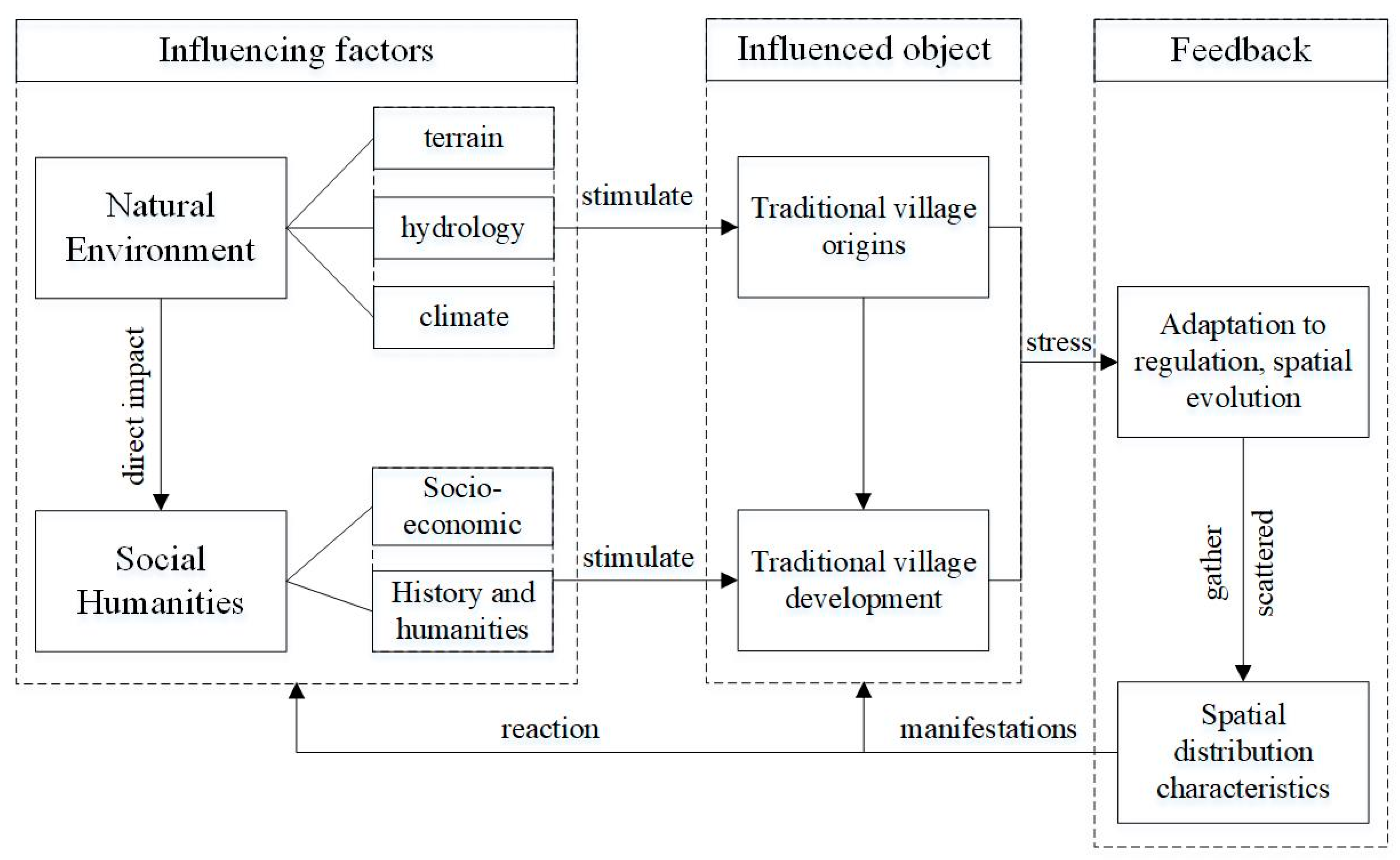

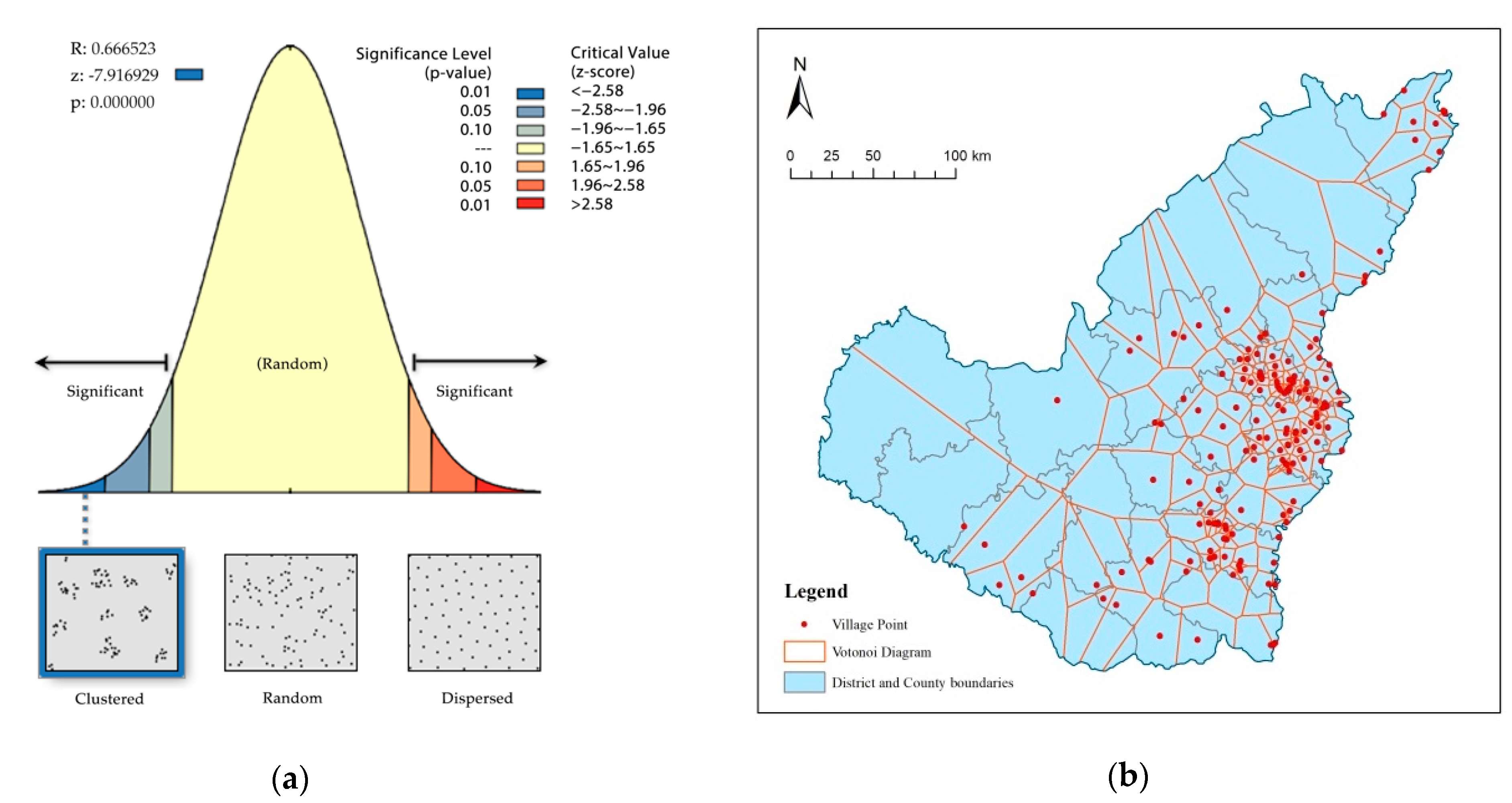
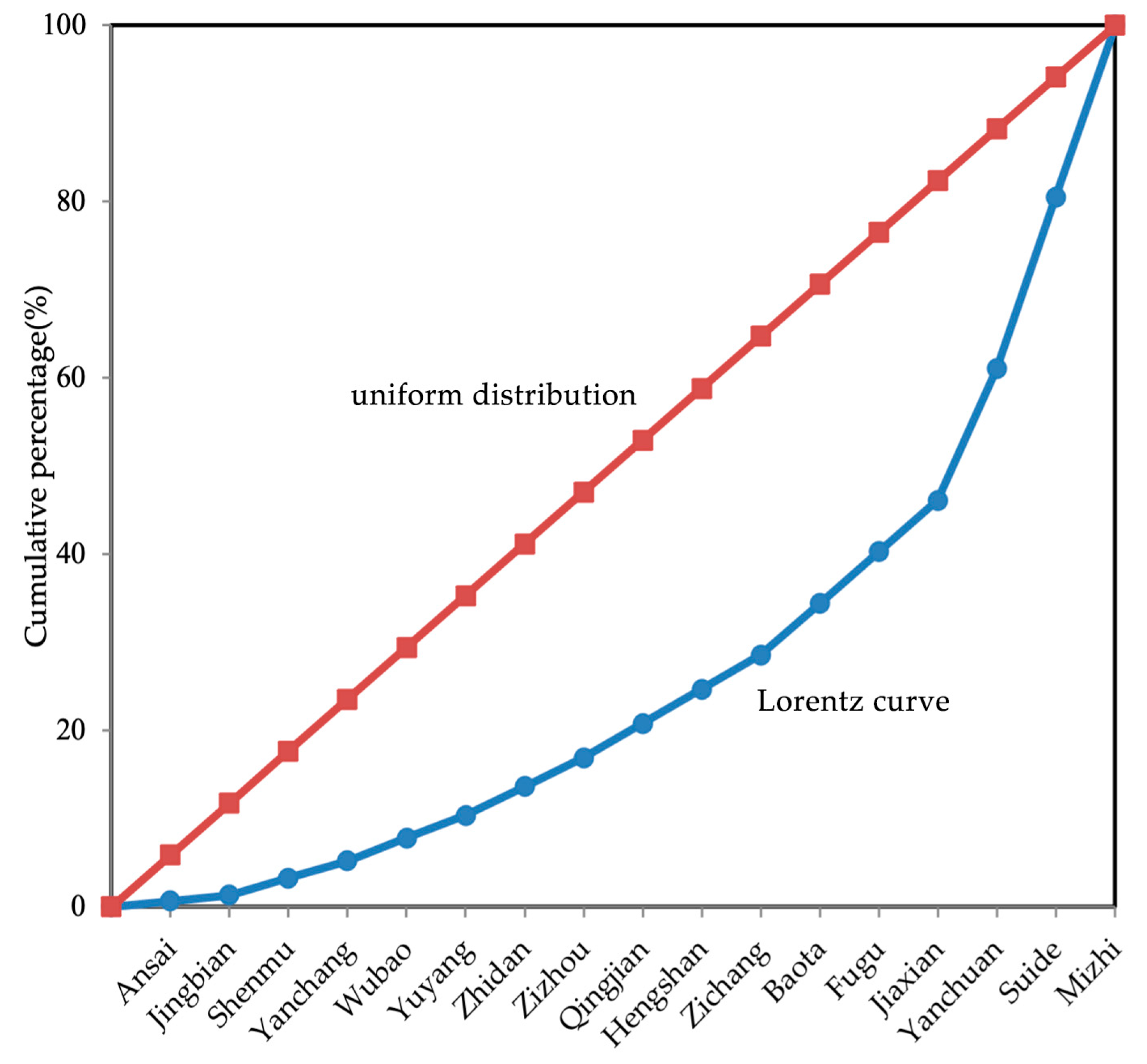
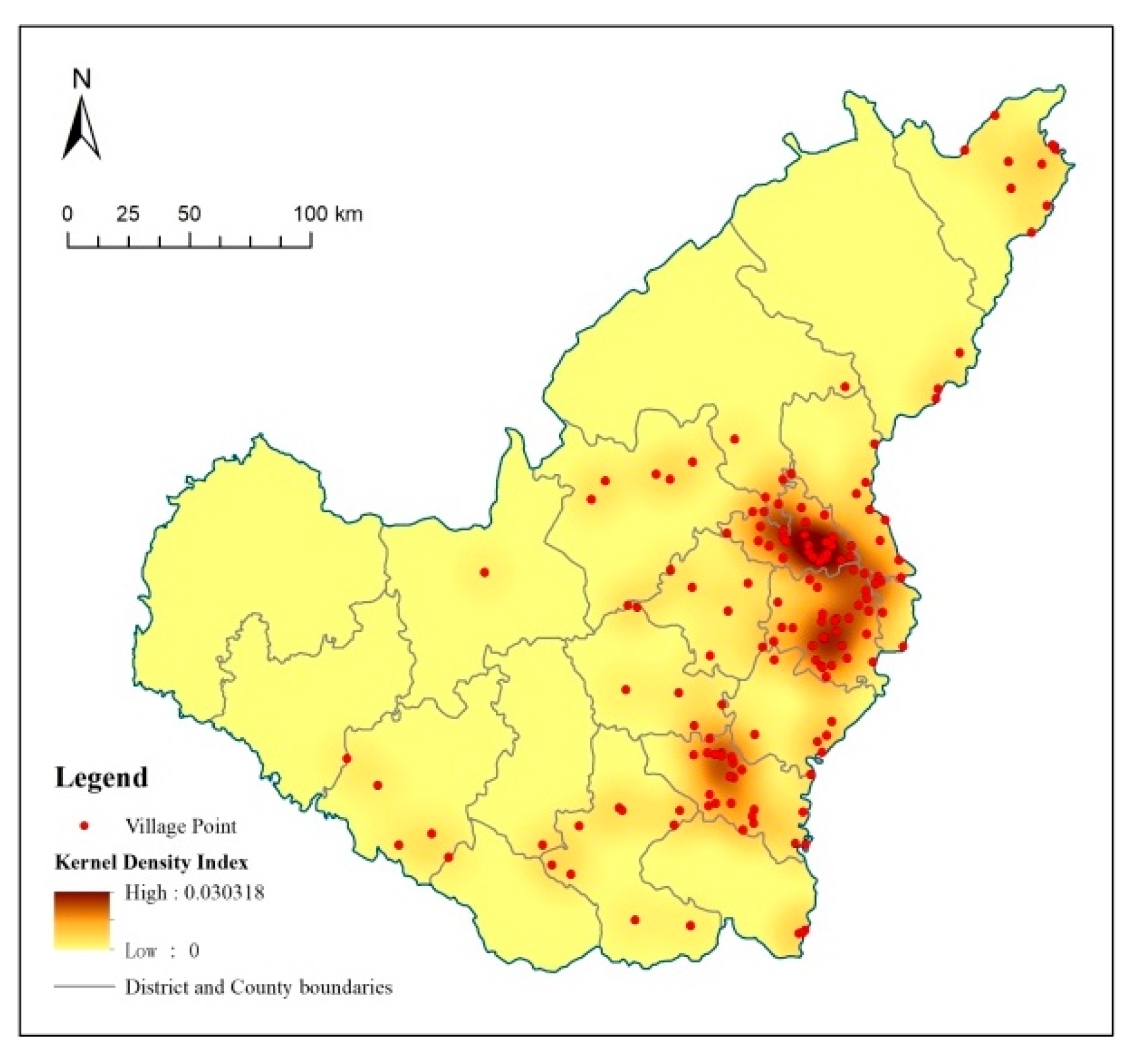
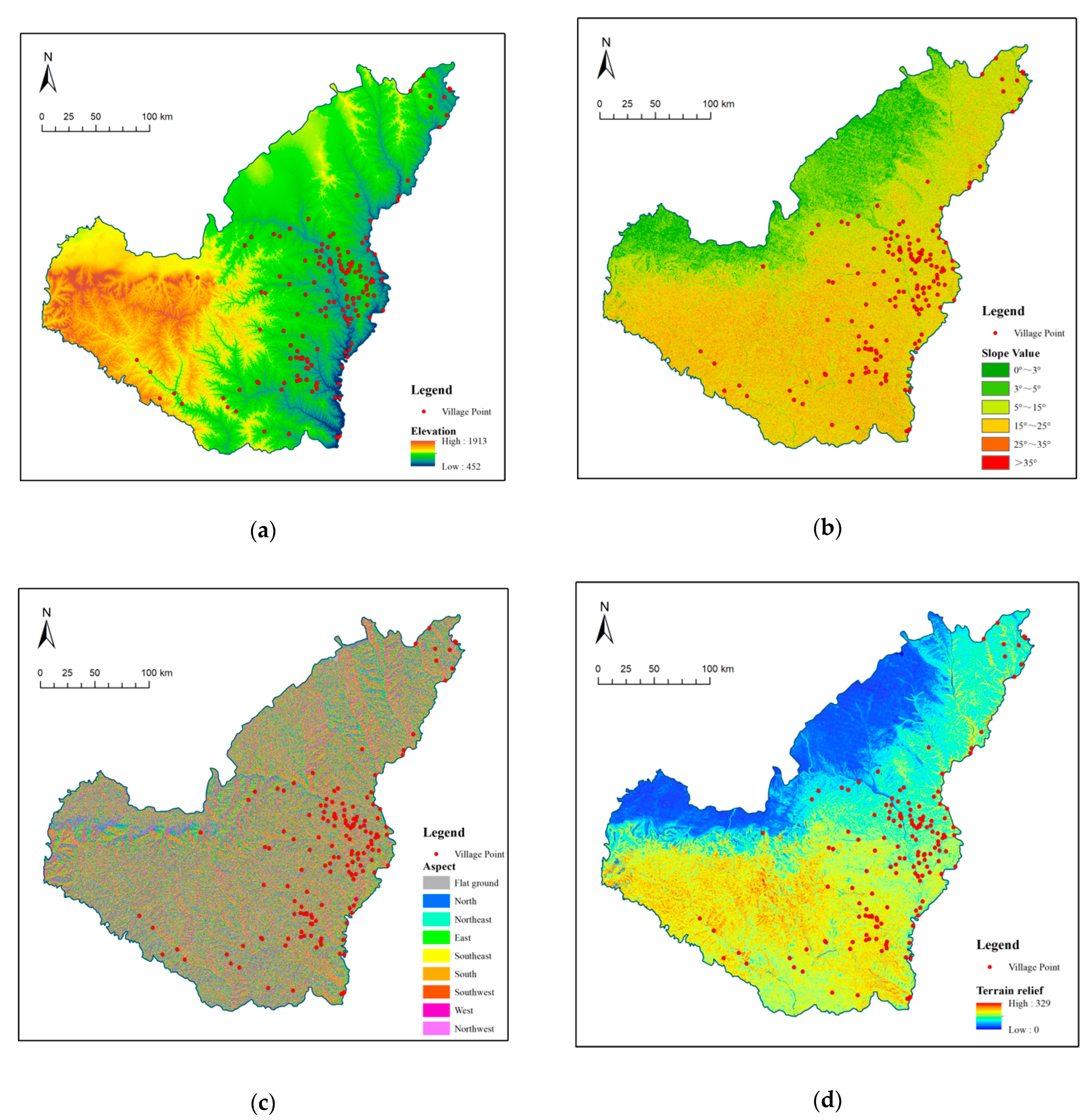
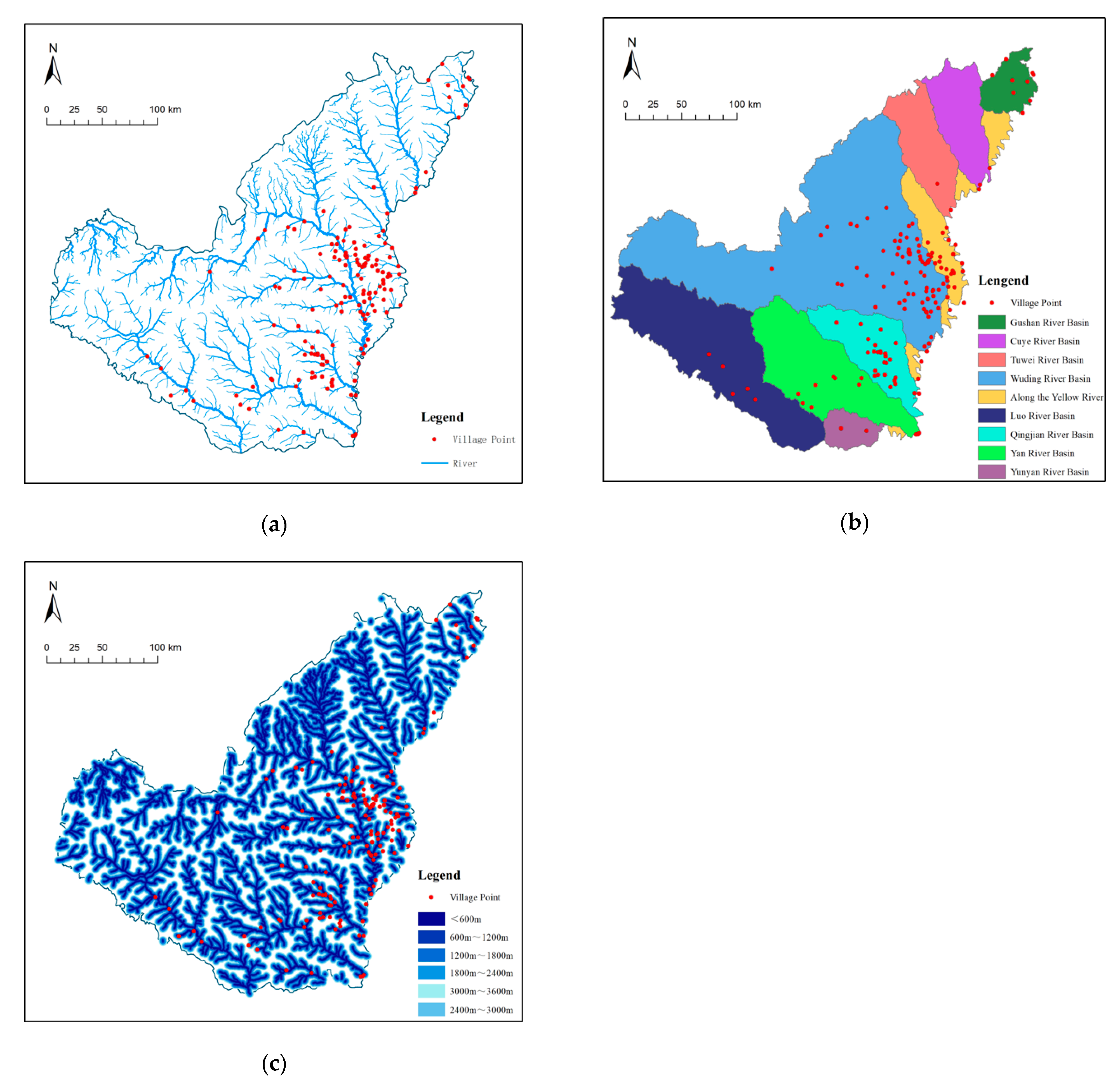
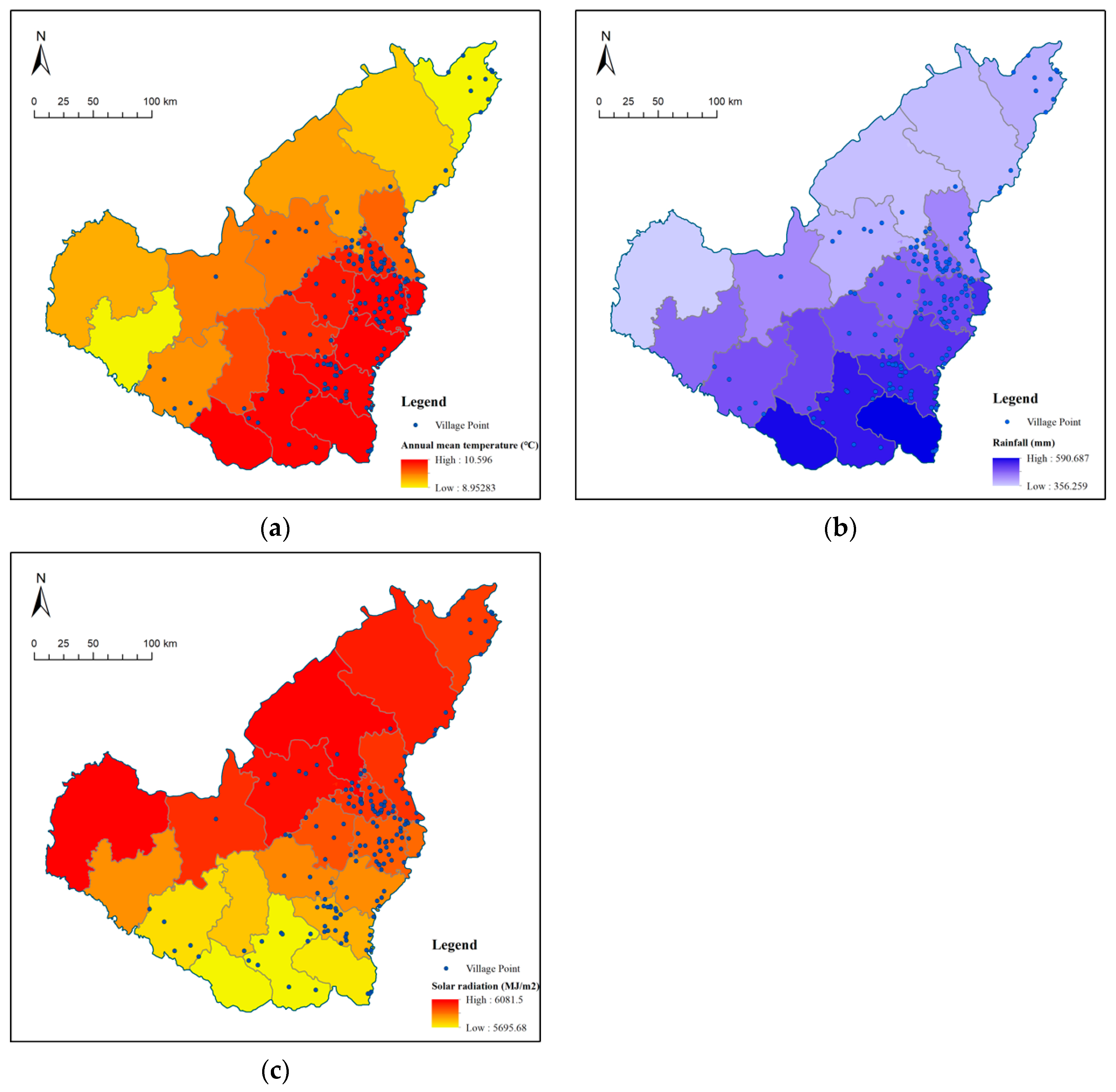

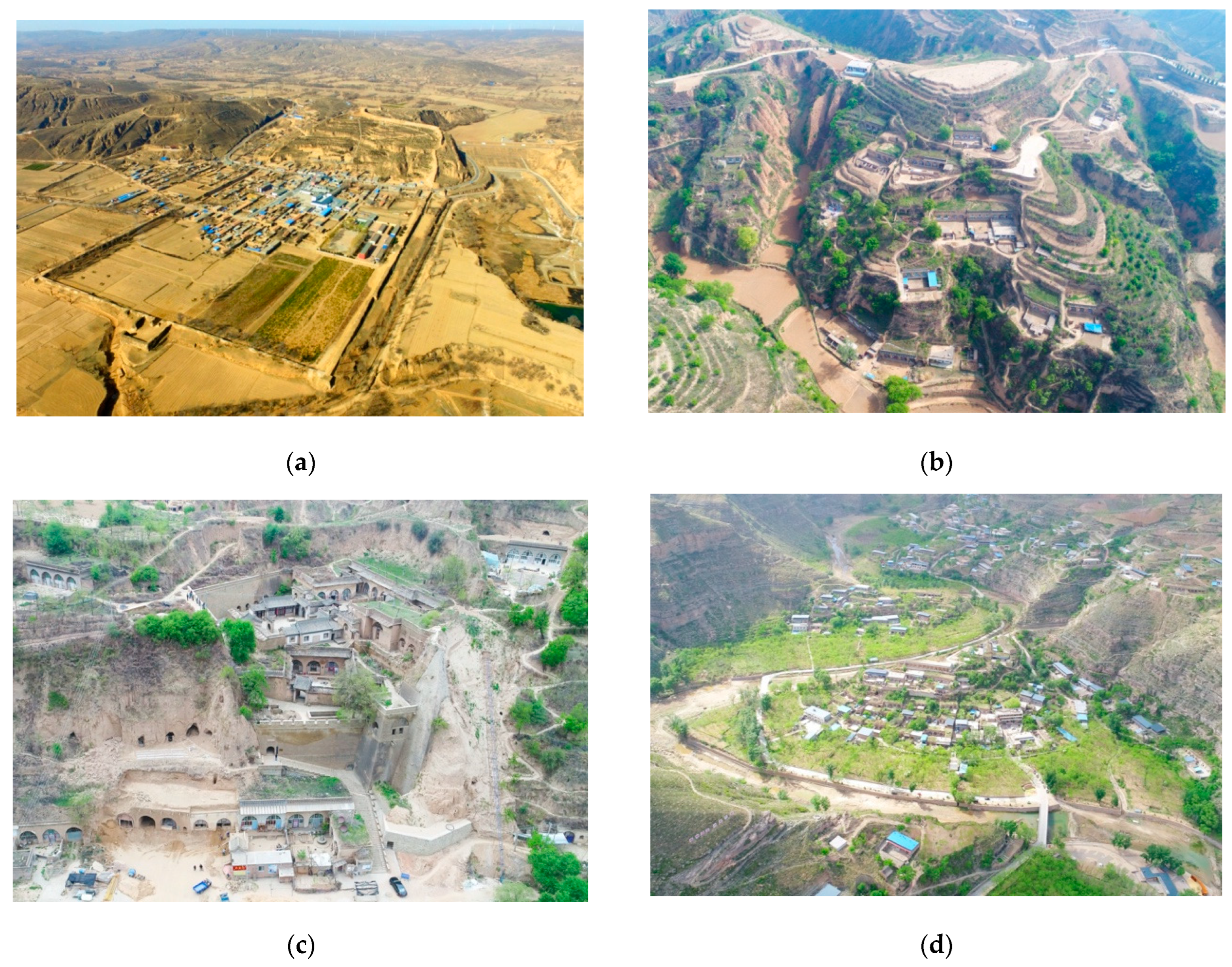
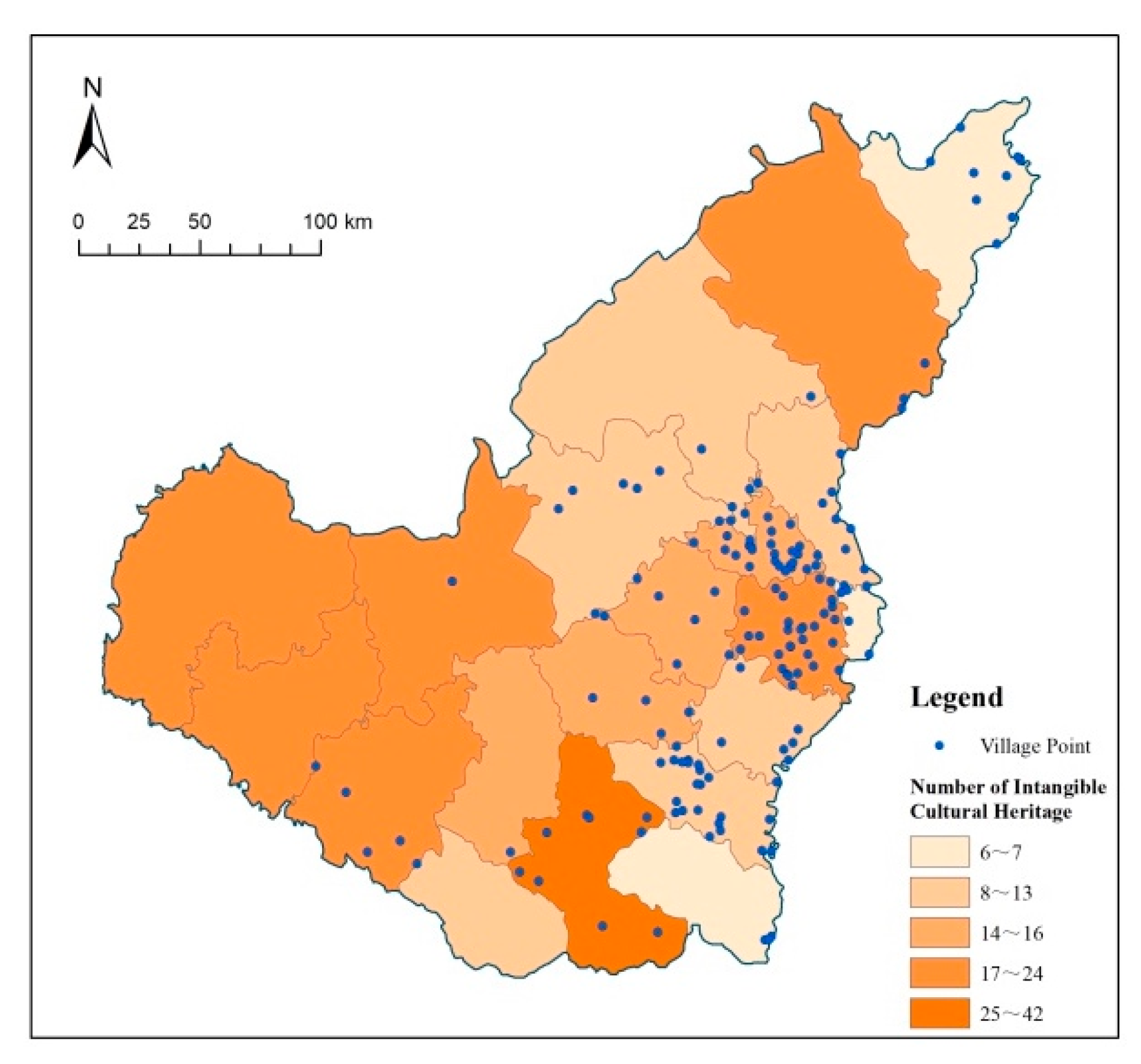

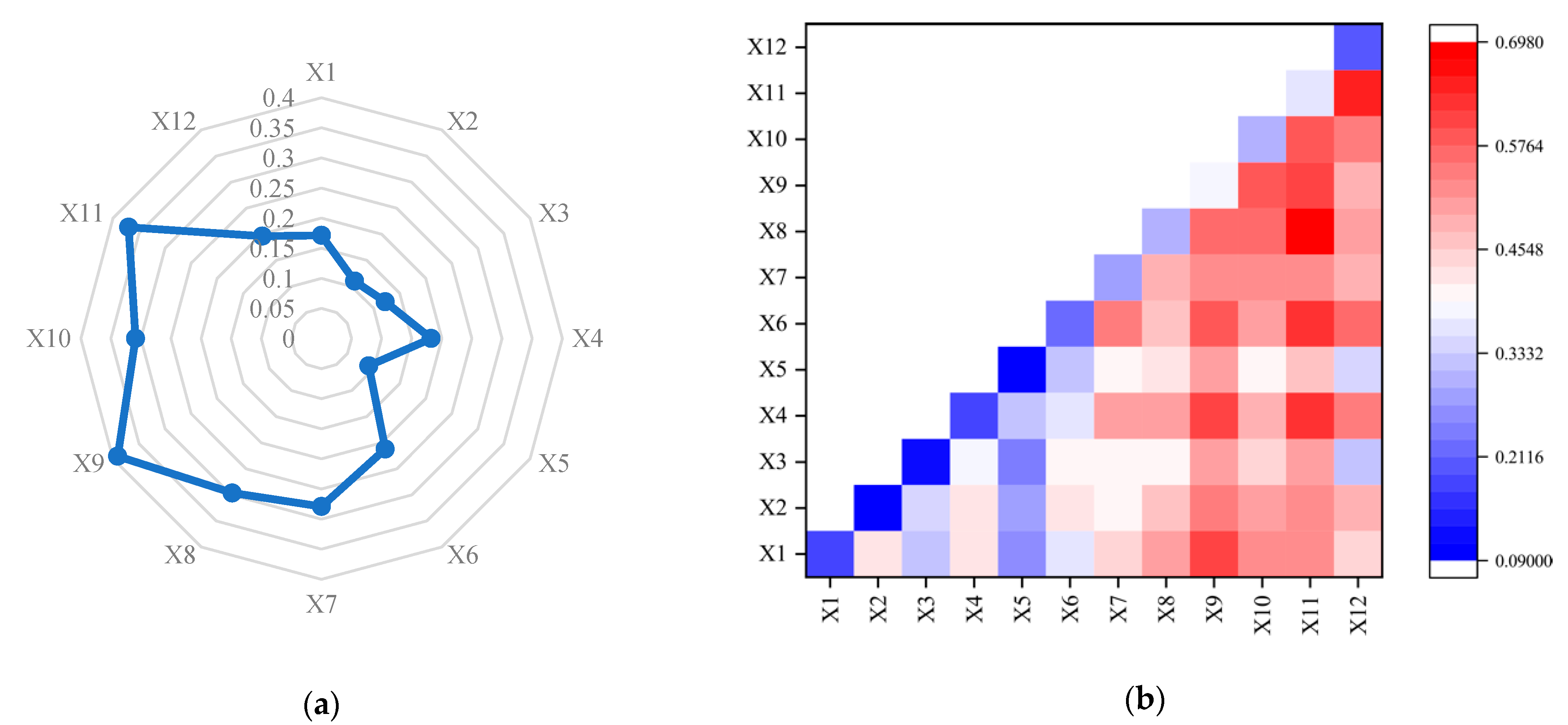
| Indicator | Formula | Explanation | Significance |
|---|---|---|---|
| Average Nearest Neighbor Index | In the formula, is the nearest distance, and is the theoretical nearest distance. | Quantitatively determines the type of distribution of point features within an area. When R > 1, the distribution of point elements is uniform; when R = 1, the dotted features are random; when R < 1, the dotted features have a tendency to agglomerate and distribute. | |
| Voronoi Diagram | In the formula, is the standard deviation of the polygon area of Tyson, and is the average of the polygon area of Tyson. | The degree to which the reaction points change relative to each other in space. If , the dotted elements are randomly distributed. If , the point elements are agglomerated. If , the dotted features are evenly distributed. | |
| Imbalance Index | In the formula, is the number of districts and counties, and is the percentage of traditional villages in each district and county in the ith place after ranking the proportion of the total number of study areas from largest to smallest. | Reflects the balance of traditional villages in different areas. is between 0 and 1, and the larger the value, the higher the imbalance. If the traditional villages are evenly distributed in all districts and counties, then , and if the traditional villages are all concentrated in one district and county, then . | |
| Index of Geographic Concentration | In the formula, is the number of traditional villages in the ith district, n is the number of districts and counties, and T is the total number of traditional villages. | An important indicator to measure the concentration of traditional villages. The value of G is between 0 and 100; the larger the G-value, the more concentrated the distribution of traditional villages; the smaller the G-value, the more dispersed the distribution. | |
| Kernel Density Analysis | In the formula, is the location of the traditional village to be estimated, is a traditional village with s as the center, and h is the location of the ith traditional village within the radius space. | Observe. the cohesion of point features throughout the study area. The larger the -value, the denser the dotted features. | |
| GeoDetector | In the formula, the value is a measure of the detection force of the independent variable—the value is [0, 1], and the closer to 1, the greater the influence of the factor. is the stratification of the independent or dependent variable, and are the number of elements and the variance of layer h, respectively, and and are the number of units and the variance of the whole, respectively. | In this paper, the factor detection method in GeoDetector is used to analyze the strength of each factor on spatial differentiation. |
| City/County/District Name | Quantity of Villages | Percentage (%) | |
|---|---|---|---|
| Yulin | Yuyang | 4 | 2.60 |
| Hengshan | 6 | 3.90 | |
| Shenmu | 3 | 1.95 | |
| Fugu | 9 | 5.84 | |
| Jingbian | 1 | 0.65 | |
| Suide | 30 | 19.48 | |
| Mizhi | 30 | 19.48 | |
| Jiaxian | 9 | 5.84 | |
| Wubao | 4 | 2.60 | |
| Qingjian | 6 | 3.90 | |
| Zizhou | 5 | 3.25 | |
| Yan’an | Baota | 9 | 5.84 |
| Ansai | 1 | 0.65 | |
| Zichang | 6 | 3.90 | |
| Yanchuan | 23 | 14.94 | |
| Yanchang | 3 | 1.95 | |
| Zhidan | 5 | 3.25 | |
Publisher’s Note: MDPI stays neutral with regard to jurisdictional claims in published maps and institutional affiliations. |
© 2022 by the authors. Licensee MDPI, Basel, Switzerland. This article is an open access article distributed under the terms and conditions of the Creative Commons Attribution (CC BY) license (https://creativecommons.org/licenses/by/4.0/).
Share and Cite
Li, B.; Wang, J.; Jin, Y. Spatial Distribution Characteristics of Traditional Villages and Influence Factors Thereof in Hilly and Gully Areas of Northern Shaanxi. Sustainability 2022, 14, 15327. https://doi.org/10.3390/su142215327
Li B, Wang J, Jin Y. Spatial Distribution Characteristics of Traditional Villages and Influence Factors Thereof in Hilly and Gully Areas of Northern Shaanxi. Sustainability. 2022; 14(22):15327. https://doi.org/10.3390/su142215327
Chicago/Turabian StyleLi, Bingqian, Jun Wang, and Yibing Jin. 2022. "Spatial Distribution Characteristics of Traditional Villages and Influence Factors Thereof in Hilly and Gully Areas of Northern Shaanxi" Sustainability 14, no. 22: 15327. https://doi.org/10.3390/su142215327
APA StyleLi, B., Wang, J., & Jin, Y. (2022). Spatial Distribution Characteristics of Traditional Villages and Influence Factors Thereof in Hilly and Gully Areas of Northern Shaanxi. Sustainability, 14(22), 15327. https://doi.org/10.3390/su142215327




